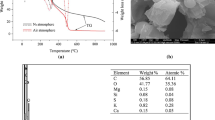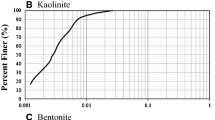Abstract
Soil pollution with petroleum-based fuels is a serious issue causing environmental problems. Recently, the use of plasma technologies for soil remediation has shown an interest and great potential. The remediation process can be performed in a fast timeframe without adding supplementary chemical reagents or without additional pre-treatment of the polluted soil. As a result, the use of plasma enables to obtain highly effective degradation of pollutants. Thus, in the present experimental research, diesel fuel removal from contaminated soil by utilizing thermal water vapor arc plasma was investigated. It was found that increased concentration of diesel fuel in the soil raised carbon and hydrogen concentrations in the soil. Moreover, soil surface morphology was modified by causing the formation of bigger agglomerates. It was also determined that after the plasma treatment process, soil grains became akin in size and structure to clean soil grains. A complete desorption of carbon, which came from diesel fuel to the soil, and a slight decomposition of organic carbon present in the soil were observed during the soil remediation process. Thermogravimetric analysis showed that regardless of the diesel fuel concentration in the soil, four stages of mass loss were observed: moisture loss, vaporization, and combustion of diesel fuel as well as reduction of volatiles and char in the soil. Producer gas analysis indicated that during soil remediation diesel fuel was mainly converted to synthesis gas, i.e., a mixture of H2, CO, and CO2. Moreover, the decomposition of diesel fuel and the formation of synthesis gas depended on the amount of pollutant in the soil. According to the obtained results, thermal water vapor arc plasma was able to completely remove diesel fuel from polluted soil in the form of synthesis gas with no significant influence on soil’s properties.






Similar content being viewed by others
References
Aggelopoulos CA (2016) Atmospheric pressure dielectric barrier discharge for the remediation of soil contaminated by organic pollutants. Int J Environ Sci Technol 13:1731–1740. https://doi.org/10.1007/s13762-016-1009-0
Aggelopoulos CA, Gkelios A, Klapa MI et al (2016) Parametric analysis of the operation of a non-thermal plasma reactor for the remediation of NAPL-polluted soils. Chem Eng J 301:353–361. https://doi.org/10.1016/j.cej.2016.05.017
Aggelopoulos CA, Tsakiroglou CD, Ognier S, Cavadias S (2015) Non-aqueous phase liquid-contaminated soil remediation by ex situ dielectric barrier discharge plasma. Int J Environ Sci Technol 12:1011–1020. https://doi.org/10.1007/s13762-013-0489-4
Aleme HG, Corgozinho CNC, Barbeira PJS (2010) Diesel oil discrimination by origin and type using physicochemical properties and multivariate analysis. Fuel 89:3151–3156. https://doi.org/10.1016/j.fuel.2010.05.010
Bocos E, Fernández-Costas C, Pazos M, Sanromán MÁ (2015) Removal of PAHs and pesticides from polluted soils by enhanced electrokinetic-Fenton treatment. Chemosphere 125:168–174. https://doi.org/10.1016/j.chemosphere.2014.12.049
Boulakradeche MO, Akretche DE, Cameselle C, Hamidi N (2015) Enhanced electrokinetic remediation of hydrophobic organics contaminated soils by the combination of non-ionic and ionic surfactants. Electrochim Acta 174:1057–1066. https://doi.org/10.1016/j.electacta.2015.06.091
Chau SW, Lu SY, Wang PJ (2011) Modeling of axis-symmetric steam plasma flow in a non-transferred torch. Comput Phys Commun 182:152–154. https://doi.org/10.1016/j.cpc.2010.08.011
Chen T, Delgado AG, Yavuz BM et al (2017) Interpreting interactions between ozone and residual petroleum hydrocarbons in soil. Environ Sci Technol 51:506–513. https://doi.org/10.1021/acs.est.6b04534
Cheng M, Zeng G, Huang D et al (2016) Hydroxyl radicals based advanced oxidation processes (AOPs) for remediation of soils contaminated with organic compounds: a review. Chem Eng J 284:582–598. https://doi.org/10.1016/j.cej.2015.09.001
Davazdah Emami S, Kasmani RMd, Hamid MD, et al (2016) Kinetic and dynamic analysis of hydrogen-enrichment mixtures in combustor systems – a review paper. Renew Sust Energ Rev 62:1072–1082. doi: https://doi.org/10.1016/j.rser.2016.05.029
Demirbas A, Bamufleh HS (2017) Optimization of crude oil refining products to valuable fuel blends. Pet Sci Technol 35:406–412. https://doi.org/10.1080/10916466.2016.1261162
Gomez E, Rani DA, Cheeseman CR, Deegan D, Wise M, Boccaccini AR (2009) Thermal plasma technology for the treatment of wastes: a critical review. J Hazard Mater 161:614–626. https://doi.org/10.1016/j.jhazmat.2008.04.017
Hrabovsky M, Hlina M, Kopecky V, Maslani A, Krenek P, Serov A, Hurba O (2018) Steam plasma methane reforming for hydrogen production. Plasma Chem Plasma Process 38:743–758. https://doi.org/10.1007/s11090-018-9891-5
Hrabovsky M, Hlina M, Kopecky V, Maslani A, Zivny O, Krenek P, Serov A, Hurba O (2017) Steam plasma treatment of organic substances for hydrogen and syngas production. Plasma Chem Plasma Process 37:739–762. https://doi.org/10.1007/s11090-016-9783-5
Kermani M, Ebadi T (2012) The effect of oil contamination on the geotechnical properties of fine-grained soils. soil and sediment contamination. An International Journal 21:655–671. https://doi.org/10.1080/15320383.2012.672486
Khudur LS, Shahsavari E, Miranda AF, Morrison PD, Nugegoda D, Ball AS (2015) Evaluating the efficacy of bioremediating a diesel-contaminated soil using ecotoxicological and bacterial community indices. Environ Sci Pollut Res 22:14809–14819. https://doi.org/10.1007/s11356-015-4624-2
Lahel A, Fanta AB, Sergienko N et al (2016) Effect of process parameters on the bioremediation of diesel contaminated soil by mixed microbial consortia. Int Biodeterior Biodegrad 113:375–385. https://doi.org/10.1016/j.ibiod.2016.05.005
Li R, Liu Y, Cheng W et al (2016) Study on remediation of phenanthrene contaminated soil by pulsed dielectric barrier discharge plasma: the role of active species. Chem Eng J 296:132–140. https://doi.org/10.1016/j.cej.2016.03.054
Li R, Liu Y, Mu R, Cheng W, Ognier S (2017) Evaluation of pulsed corona discharge plasma for the treatment of petroleum-contaminated soil. Environ Sci Pollut Res 24:1450–1458. https://doi.org/10.1007/s11356-016-7929-x
Lim MW, Lau EV, Poh PE (2016) A comprehensive guide of remediation technologies for oil contaminated soil — present works and future directions. Mar Pollut Bull 109:14–45. https://doi.org/10.1016/j.marpolbul.2016.04.023
Lominchar MA, Santos A, de Miguel E, Romero A (2018) Remediation of aged diesel contaminated soil by alkaline activated persulfate. Sci Total Environ 622–623:41–48. https://doi.org/10.1016/j.scitotenv.2017.11.263
Lu N, Wang C, Lou C (2017) Remediation of PAH-contaminated soil by pulsed corona discharge plasma. J Soils Sediments 17:97–105. https://doi.org/10.1007/s11368-016-1473-7
Ma F, Zhang Q, Wu B, Peng C, Li N, Li F, Gu Q (2018) Treatment of PAH-contaminated soil using cement-activated persulfate. Environ Sci Pollut Res 25:887–895. https://doi.org/10.1007/s11356-017-0268-8
Maghbouli A, Yang W, An H et al (2014) Modeling knocking combustion in hydrogen assisted compression ignition diesel engines. Energy 76:768–779. https://doi.org/10.1016/j.energy.2014.08.074
Martin S, Kraaij G, Ascher T et al (2015) Direct steam reforming of diesel and diesel–biodiesel blends for distributed hydrogen generation. Int J Hydrog Energy 40:75–84. https://doi.org/10.1016/j.ijhydene.2014.10.062
Maximini M, Engelhardt P, Grote M, Brenner M (2012) Further development of a microchannel steam reformer for diesel fuel. Int J Hydrog Energy 37:10125–10134. https://doi.org/10.1016/j.ijhydene.2012.03.093
Ni G, Zhao P, Cheng C et al (2012) Characterization of a steam plasma jet at atmospheric pressure. Plasma Sources Sci Technol 21:015009. https://doi.org/10.1088/0963-0252/21/1/015009
O’Brien PL, DeSutter TM, Casey FXM et al (2018) Thermal remediation alters soil properties – a review. J Environ Manag 206:826–835. https://doi.org/10.1016/j.jenvman.2017.11.052
Rahman Z, Rahman H, Rahman A (2014) Classification and generation of atmospheric pressure plasma and its principle applications 2:20
Raslavičius L, Striūgas N, Felneris M et al (2018) Thermal characterization of P. moriformis oil and biodiesel. Fuel 220:140–150. https://doi.org/10.1016/j.fuel.2018.02.010
Redolfi M, Makhloufi C, Ognier S, Cavadias S (2010) Oxidation of kerosene components in a soil matrix by a dielectric barrier discharge reactor. Process Saf Environ Prot 88:207–212. https://doi.org/10.1016/j.psep.2010.01.005
Reşitoğlu İA, Altinişik K, Keskin A (2015) The pollutant emissions from diesel-engine vehicles and exhaust aftertreatment systems. Clean Techn Environ Policy 17:15–27. https://doi.org/10.1007/s10098-014-0793-9
Roy AS, Baruah R, Borah M et al (2014) Bioremediation potential of native hydrocarbon degrading bacterial strains in crude oil contaminated soil under microcosm study. Int Biodeterior Biodegrad 94:79–89. https://doi.org/10.1016/j.ibiod.2014.03.024
Rutberg PG, Kuznetsov VA, Serba EO et al (2013) Study of electric arcs in an air-steam mixture in AC plasma torches. high Temperature 51:608–614. https://doi.org/10.1134/S0018151X13050180
Samal S (2017) Thermal plasma technology: The prospective future in material processing. J Clean Prod 142:3131–3150. https://doi.org/10.1016/j.jclepro.2016.10.154
Sandu C, Popescu M, Rosales E et al (2017) Electrokinetic oxidant soil flushing: a solution for in situ remediation of hydrocarbons polluted soils. J Electroanal Chem 799:1–8. https://doi.org/10.1016/j.jelechem.2017.05.036
Sanlisoy A, Carpinlioglu MO (2017) A review on plasma gasification for solid waste disposal. Int J Hydrog Energy 42:1361–1365. https://doi.org/10.1016/j.ijhydene.2016.06.008
Scafutto RDM, de Souza Filho CR, de Oliveira WJ (2017) Hyperspectral remote sensing detection of petroleum hydrocarbons in mixtures with mineral substrates: implications for onshore exploration and monitoring. ISPRS J Photogramm Remote Sens 128:146–157. https://doi.org/10.1016/j.isprsjprs.2017.03.009
Snellings R, Mertens G, Elsen J (2012) supplementary cementitious materials. Rev Mineral Geochem 74:211–278. https://doi.org/10.2138/rmg.2012.74.6
Szymkowicz PG, Benajes J (2018) Development of a diesel surrogate fuel library. Fuel 222:21–34. https://doi.org/10.1016/j.fuel.2018.01.112
Taheri S, Ebadi T, Maknoon R, Amiri M (2018) Predicting variations in the permeability and strength parameters of a sand-bentonite mixture (SBM) contaminated simultaneously with lead (II) and diesel. Appl Clay Sci 157:102–110. https://doi.org/10.1016/j.clay.2018.01.007
Tamošiūnas A, Grigaitienė V, Valatkevičius P, Valinčius V (2012) Syngas production from hydrocarbon-containing gas in ambient of water vapor plasma. Catal Today 196:81–85. https://doi.org/10.1016/j.cattod.2012.05.027
Tamošiūnas A, Valatkevičius P, Gimžauskaitė D, Jeguirim M, Mėčius V, Aikas M (2017a) Energy recovery from waste glycerol by utilizing thermal water vapor plasma. Environ Sci Pollut Res Int 24:10030–10040. https://doi.org/10.1007/s11356-016-8097-8
Tamošiūnas A, Valatkevičius P, Gimžauskaitė D et al (2017b) Glycerol steam reforming for hydrogen and synthesis gas production. Int J Hydrog Energy 42:12896–12904. https://doi.org/10.1016/j.ijhydene.2016.12.071
Tang L, Huang H, Hao H, Zhao K (2013) Development of plasma pyrolysis/gasification systems for energy efficient and environmentally sound waste disposal. J Electrost 71:839–847. https://doi.org/10.1016/j.elstat.2013.06.007
Tatarova E, Bundaleska N, Sarrette JP, Ferreira CM (2014) Plasmas for environmental issues: from hydrogen production to 2D materials assembly. Plasma Sources Sci Technol 23:063002. https://doi.org/10.1088/0963-0252/23/6/063002
Tendero C, Tixier C, Tristant P et al (2006) Atmospheric pressure plasmas: a review. Spectrochim Acta, Part B 61:2–30. https://doi.org/10.1016/j.sab.2005.10.003
Vempatapu BP, Kanaujia PK (2017) Monitoring petroleum fuel adulteration: a review of analytical methods. TrAC Trends Anal Chem 92:1–11. https://doi.org/10.1016/j.trac.2017.04.011
Wang T, Qu G, Sun Q et al (2015) Formation and roles of hydrogen peroxide during soil remediation by direct multi-channel pulsed corona discharge in soil. Sep Purif Technol 147:17–23. https://doi.org/10.1016/j.seppur.2015.04.010
Wang TC, Lu N, Li J, Wu Y (2010) Degradation of pentachlorophenol in soil by pulsed corona discharge plasma. J Hazard Mater 180:436–441. https://doi.org/10.1016/j.jhazmat.2010.04.049
Wang TC, Qu G, Li J, Liang D (2014a) Evaluation of the potential of soil remediation by direct multi-channel pulsed corona discharge in soil. J Hazard Mater 264:169–175. https://doi.org/10.1016/j.jhazmat.2013.11.011
Wang TC, Qu G, Li J, Liang D (2014b) Evaluation and optimization of multi-channel pulsed discharge plasma system for soil remediation. Vacuum 103:72–77. https://doi.org/10.1016/j.vacuum.2013.12.012
Wang TC, Qu G, Li J, Lu N (2014c) Transport characteristics of gas phase ozone in soil during soil remediation by pulsed discharge plasma. Vacuum 101:86–91. https://doi.org/10.1016/j.vacuum.2013.07.020
Yus M, Soler J, Herguido J, Menéndez M (2018) Glycerol steam reforming with low steam/glycerol ratio in a two-zone fluidized bed reactor. Catal Today 299:317–327. https://doi.org/10.1016/j.cattod.2017.08.040
Zhang H, Ma D, Qiu R et al (2017) Non-thermal plasma technology for organic contaminated soil remediation: a review. Chem Eng J 313:157–170. https://doi.org/10.1016/j.cej.2016.12.067
Funding
This research was financially supported by the Public Agency “Soil remediation technologies,” project No. 17-34/15-1775.17.18.
Author information
Authors and Affiliations
Corresponding author
Additional information
Responsible editor: Philippe Garrigues
Publisher’s note
Springer Nature remains neutral with regard to jurisdictional claims in published maps and institutional affiliations.
Rights and permissions
About this article
Cite this article
Gimžauskaitė, D., Tamošiūnas, A., Tučkutė, S. et al. Treatment of diesel-contaminated soil using thermal water vapor arc plasma. Environ Sci Pollut Res 27, 43–54 (2020). https://doi.org/10.1007/s11356-019-06697-4
Received:
Accepted:
Published:
Issue Date:
DOI: https://doi.org/10.1007/s11356-019-06697-4




